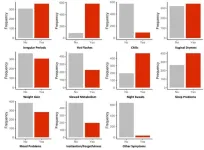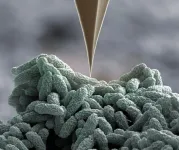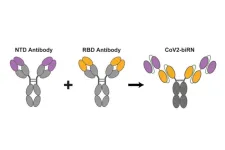(Press-News.org) ITHACA, N.Y. – A Cornell University-led collaboration devised a new method for designing metals and alloys that can withstand extreme impacts, which could lead to the development of automobiles, aircraft and armor that can better endure high-speed impacts, extreme heat and stress.
The research, published in Communications Materials, introduces nanometer-scale speed bumps that suppress a fundamental transition that controls how metallic materials deform.
The project was led by Mostafa Hassani, assistant professor of mechanical and aerospace engineering, in collaboration with researchers from the Army Research Laboratory (ARL). The paper’s co-lead authors were doctoral candidate Qi Tang and postdoctoral researcher Jianxiong Li.
When a metallic material is struck at an extremely high speed – think highway collisions and ballistic impacts – the material immediately ruptures and fails. The reason for that failure is embrittlement – the material loses ductility (the ability to bend without breaking) when deformed rapidly. However, embrittlement is a fickle process: If you take the same material and bend it slowly, it will deform but not break right way.
That malleable quality in metals is the result of tiny defects, or dislocations, that move through the crystalline grain until they encounter a barrier. During rapid, extreme strains, the dislocations accelerate – at speeds of kilometers per second – and begin interacting with lattice vibrations, or phonons, which create a substantial resistance. This is where a fundamental transition occurs – from a so-called thermally activated glide to a ballistic transport – leading to significant drag and, ultimately, embrittlement.
Hassani’s team worked with the ARL researchers to create a nanocrystalline alloy, copper-tantalum (Cu-3Ta). Nanocrystalline copper’s grains are so small, the dislocations’ movement would be inherently limited, and that movement was further confined by the inclusion of nanometer clusters of tantalum inside the grains.
To test the material, Hassani’s lab used a custom-built tabletop platform that launches, via laser pulse, spherical microprojectiles that are 10 microns in size and reach speeds of up to 1 kilometer per second – faster than an airplane. The microprojectiles strike a target material, and the impact is recorded by a high-speed camera. The researchers ran the experiment with pure copper, then with copper-tantalum. They also repeated the experiment at a slower rate with a spherical tip that was gradually pushed into the substrate, indenting it.
In a conventional metal or alloy, dislocations can travel several dozen microns without any barriers. But in nanocrystalline copper-tantalum, the dislocations could barely move more than a few nanometers, which are 1,000 times smaller than a micron, before they were stopped in their tracks. Embrittlement was effectively suppressed.
“This is the first time we see a behavior like this at such a high rate. And this is just one microstructure, one composition that we have studied,” Hassani said. “Can we tune the composition and microstructure to control dislocation-phonon drag? Can we predict the extent of dislocation-phonon interactions?”
The research was supported by the National Science Foundation and the Army Research Office.
For additional information, see this Cornell Chronicle story.
-30-
END
Nanoscale tweaks help alloy withstand high-speed impacts
2025-03-05
ELSE PRESS RELEASES FROM THIS DATE:
AI-generated voices which sound like you are perceived as more trustworthy and likeable, with implications for deep-fakes and manipulation
2025-03-05
AI-generated voices which sound like you are perceived as more trustworthy and likeable, with implications for deep-fakes and manipulation
Article URL: https://plos.io/4baFCW5
Article title: AI-determined similarity increases likability and trustworthiness of human voices
Author countries: Germany
Funding: The author(s) received no specific funding for this work. END ...
The cacao tree species (Theobroma cacao L.), from which we get chocolate, is likely about 7.5 million years old, with chloroplast genomes indicating that the current known diversity diversified during
2025-03-05
The cacao tree species (Theobroma cacao L.), from which we get chocolate, is likely about 7.5 million years old, with chloroplast genomes indicating that the current known diversity diversified during the Pliocene or Miocene epochs
Article URL: https://plos.io/4gQHlB2
Article title: Comparative analyses of chloroplast genomes of Theobroma cacao from northern Peru
Author countries: Perú
Funding: This study was supported by the Programa Nacional de Investigación Científica y Estudios Avanzados (PROCIENCIA) funded by the Project through the Contract N° 026-2016-FONDECYT “Círculo de Investigación ...
After sexual misconduct accusations, scholars’ work is cited less
2025-03-05
In a new analysis, scholars publicly accused of sexual misconduct experienced a significant decrease in the rate at which other scholars cited their published research. Giulia Maimone of the University of California, Los Angeles, U.S., and colleagues present these findings in the open-access journal PLOS One on March 5, 2025.
In academia, scholars cite other scholars’ publications as a widely agreed-upon way to reference existing research and promote scientific advancement. A scholar with a high number of citations may be considered particularly impactful in their field. Prior research ...
Menopause symptoms associated with future memory and neuropsychiatric problems
2025-03-05
Women who exhibit more menopausal symptoms are more likely to later have poorer cognitive function and mild behavioral impairments – both markers of dementia. That is the conclusion of a study of 896 postmenopausal females published March 5, 2025, in the open-access journal PLOS One by Zahinoor Ismail of University of Calgary, Canada, and colleagues.
Females are known to have a three-fold greater risk of developing Alzheimer’s disease and related dementias, and will be disproportionately ...
Findings may advance understanding of infertility in mothers
2025-03-05
Oxytocin, a hormone already known for its role in childbirth, milk release, and mother-infant bonding, may have a newfound purpose in mammalian reproduction. In times of maternal stress, the hormone can delay an embryo’s development for days to weeks after conception, a new study in rodents shows. According to the authors, the findings about so-called “diapause” may offer new insights into pregnancy and fertility issues faced by humans.
Led by researchers at NYU Langone Health, the study explored diapause, in which an embryo temporarily stops growing early in ...
Engineered cartilage from nasal septum cells helps treat complex knee injuries
2025-03-05
Injuries to the articular cartilage in different joints, including the knee, are painful and limit mobility. Therefore, researchers at the University of Basel and University Hospital Basel are developing cartilage implants using cells from the patient’s nasal septum. A recent study shows that giving these cartilage implants more time to mature significantly improved clinical efficacy, even in patients with complex cartilage injuries. This suggests that the method could also be suitable for the treatment of degenerated cartilage in osteoarthritis.
An unlucky fall while skiing or playing ...
Damaged but not defeated: Bacteria use nano-spearguns to retaliate against attacks
2025-03-05
Some bacteria deploy tiny spearguns to retaliate against rival attacks. Researchers at the University of Basel mimicked attacks by poking bacteria with an ultra-sharp tip. Using this approach, they have uncovered that bacteria assemble their nanoweapons in response to cell envelope damage and rapidly strike back with high precision.
In the world of microbes, peaceful coexistence goes hand in hand with fierce competition for nutrients and space. Certain bacteria outcompete rivals and fend off attackers by injecting them with a lethal cocktail using tiny, ...
Among older women, hormone therapy linked to tau accumulation, a hallmark of Alzheimer’s disease
2025-03-05
A new study from Mass General Brigham researchers has found faster accumulation of tau—a key indicator of Alzheimer’s disease—in the brains of women over the age of 70 who took menopausal hormone therapy (HT) more than a decade before. Results, which are published in Science Advances, could help inform discussions between patients and clinicians about Alzheimer’s disease risk and HT treatment.
While the researchers did not see a significant difference in amyloid beta accumulation, they did find a significant difference in how fast regional tau accumulated in the brains of women over the age of 70, with women who had taken HT showing faster tau accumulation ...
Scientists catch water molecules flipping before splitting
2025-03-05
For the first time, Northwestern University scientists have watched water molecules in real-time as they prepared to give up electrons to form oxygen.
In the crucial moment before producing oxygen, the water molecules performed an unexpected trick: They flipped.
Because these acrobatics are energy intensive, the observations help explain why water splitting uses more energy than theoretical calculations suggest. The findings also could lead to new insights into increasing the efficiency of water splitting, a process that holds promise for generating clean hydrogen fuel and for producing breathable oxygen during future missions to Mars.
The study will be published Wednesday (March 5) ...
New antibodies show potential to defeat all SARS-CoV-2 variants
2025-03-05
The virus that causes COVID-19 has been very good at mutating to keep infecting people – so good that most antibody treatments developed during the pandemic are no longer effective. Now a team led by Stanford University researchers may have found a way to pin down the constantly evolving virus and develop longer-lasting treatments.
The researchers discovered a method to use two antibodies, one to serve as a type of anchor by attaching to an area of the virus that does not change very much and another to inhibit the virus’s ability ...





